Mental
The Justices of the Peace for the County of Surrey recognised that a new asylum was desperately needed and that the savings made from not paying private asylums would be more than adequate to meet the estimated cost of £150,000 of a new asylum for 1,000 inmates.
In 1880 a 200-acre site on high ground in an entirely rural district was selected. It overlooked the Chipstead and Smitham Valleys and the village of Coulsdon, and was located conveniently for access from the eastern part of the county and from the parishes within south London.
The third Surrey County Pauper Lunatic Asylum opened in December 1883. Built to high standards, it was the largest institution of its type in the United Kingdom, and became something of a showpiece. The first direct admissions came from St Olave's (later the Borough of Bermondsey). The motto of the Asylum was Aversos compono animos (I bring relief to troubled minds).
The 'radiating pavilion' layout was original - a transition between the old system of parallel blocks and the later semi-circular plan - with the ward blocks placed around a central block in a 'horse-shoe' configuration, and all joined by linking corridors. The compact design allowed good and rapid communication between the staff and patients but, because the buildings faced towards the southeast, full daylight was not able to enter and the wards were very dark.
The central block, built in the Queen Anne style, was elaborately decorated internally with wood panelling and stained glass (as were the other public areas). It contained the administrative offices, treatment rooms, a chapel, a large recreation and dining hall, the kitchens, storerooms and the laundry.
The Asylum could accommodate 1,124 patients - 644 women in the west part and 480 men in the east, with strict segregation of the sexes. They were housed in 3-storey ward blocks, with 2-storey ward pavilions between. The larger blocks had Day Rooms on the ground floor, with sleeping accommodation and single cells (for difficult patients) on the first and second floors. The 2-storey blocks were divided by the linking corridors into Day Rooms and dormitories. There were eight different designs for the wards, to accommodate the different categories of patients, such as the sick, the chronically ill and epileptics. It was believed to be helpful to keep curable patients separated from the more violent, disruptive ones.
As with similar institutions, the Asylum was designed to be a self-sufficient community, with a farm and vegetable garden in which there were also large cast-iron greenhouses. The kitchens and bakeries fed both patients and staff - almost 2,000 people. Male patients were employed on the farm, in the gardens and the workshops, while female patients worked in the kitchens, the wards and the laundry.The Asylum had its own water tower, which was surrounded by various out-buildings housing stores and utilities. It also had its own fire station, as the next nearest one was in Purley, some miles away (up until the 1970s the male nursing staff were expected to tackle any fires until the Fire Brigade arrived).
The extensive grounds were landscaped. Enclosed 'airing courts', where patients would exercise or sit outdoors, were shared by several wards, and octagonal pavilions enabled patients to enjoy the outdoors in bad weather or be shaded from the sun. Recreational activities included outdoor sports - cricket, tennis and swimming - and indoor amusements - dances, concerts and theatrical performances in the main hall (where the sexes could mix).
Treatments for the insane were limited, and the medical profession commonly believed that little could be done (the typical discharge rate from asylums at this time was less than 12%). In the late Victorian age, asylums were regarded as places of 'sanctuary', where such patients could be cared for humanely. They received an adequate diet, lived in clean conditions and were given constructive employment. Disruptive or violent patients were physically restrained by the use of a strait jacket, and placed in a padded cell. By the end of the century, water treatments began to be introduced. An agitated patient would be wrapped in cold damp sheets or given a cold shower to calm then down, or made to sit in a hot bath with an ice bag on the head. Work, exercise, sports and amusements were expected to provide a distraction for patients from their mental state.
The Local Government Act, 1888, created the County of London, and a new body - the London County Council (LCC) - was established in 1889. With the redrawing of boundaries, the Surrey parishes within and near to the City of London were transferred to the control of the LCC. As these parishes, now in south London, made up the catchment area for Cane Hill Asylum, it was agreed between the LCC and Surrey County Council that the LCC would take control of the Asylum.
By the same Act, Croydon had become a new County Borough, but had no asylum of its own. Until such a time as one could be built, an arrangement was made with the LCC for one-eighth of the Cane Hill Asylum's beds to be made available for Croydon patients. The Asylum was renamed the 'London County Council Asylum with provision for Croydon'.
The LCC immediately extended the Asylum by building two new 3-storey pavilions and a 2-storey pavilion, while work began on the erection of a Nurses' Home at the rear of the site. Completed in 1889, the new wards brought the bed accommodation to 2,000. In the same year, a railway station opened at Coulsdon, providing good transport links with London.
In 1890 the Asylum had a 40% recovery rate for the direct admissions of that year, the highest of any London mental hospital.
Between 1898 and 1914 the LCC built six additional mental asylums, but the Cane Hill Asylum remained unmodernised. Built in 1883, it was regarded as neither old nor new enough (electric lighting was not installed until the 1930s). The site, being long and narrow in shape and at varying levels, made expansion difficult, and thus no major additions were ever made. The Asylum had no modern detached admissions block, nor convalescent villas. The Nurses' Home had been left unfinished.
During WW1 the Asylum was overcrowded, resulting in widespread disease (patients in mental institutions were decimated by TB, dysentery and influenza).
In 1930 the Asylum was renamed Cane Hill Mental Hospital, when the Mental Health Act of that year expunged the term 'asylum' from official use.
In 1936 the Hospital had 386 male and 1,316 female patients. In 1937 the numbers had increased to 890 males and 1,355 females.
New physical treatments were introduced during the late 1930s, such as prolonged narcosis and convulsive treatments in 1937. The latter was superseded by electroconvulsive therapy (ECT) in 1941 (the Hospital was one of the first to use ECT). The LCC would only allow selected hospitals to use insulin coma therapy, but the medical staff at Cane Hill ignored the ruling and introduced this in 1941. Leucotomies also began to be performed in 1941.
Shortly before WW2 the Hospital had 857 male and 1,290 female patients, and there was a moderate amount of overcrowding. Contemporary standards dictated that the maximum number of disturbed patients together in one ward should be 40, but at Cane Hill the wards had been designed to accommodate 70 patients per ward. Overcrowding resulted in 80 or 90 patients per ward.
At the outbreak of WW2 Horton Hospital was taken over for war purposes and 300 of its patients were transferred to Cane Hill. Six of the wards at Cane Hill were also given up for the Emergency Medical Service (EMS), which installed an X-ray Department. The Hospital then contained 2,500 patients (compared with the normal 2,245).
Despite the overcrowding, the outbreaks of infectious diseases which had occurred during WW1 did not happen during WW2, although TB remained a problem in all mental hospitals. In 1944, when the TB unit at Banstead Hospital was bombed, its male patients were transferred to Cane Hill.
In March 1948 a patient who had climbed up onto the roof of his ward was rescued by two nurses, despite it being dark at the time. The nurses were rewarded with the Daily Herald Order of Industrial Heroism for their bravery.
In 1948, on the 'Appointed Day' of 5th July, the Hospital joined the NHS under the control of the Cane Hill Hospital Management Committee, part of the South West Metropolitan Regional Hospital Broad. While most of the catchment areas for the LCC mental hospitals in Surrey changed, Cane Hill retained its original catchment area (which lay geographically in the South East Metropolitan Regional Hospital Board region). The Hospital had 2,264 beds and 159 male and 179 female full-time nurses, with 4 male and 70 female part-timers.
The X-ray unit, installed for the EMS part of the Hospital, was used for the control and monitoring of TB and for the diagnosis of complications of convulsive treatment (that is, joint dislocation and fractures of long bones).
The patients remained employed in the workshops. All the bedding was made and remade in the upholsterers' shop, which also made curtains and repaired and recovered upholstered furniture, undertook book-binding and the laying of linoleum. The shoemakers' shop provided special and surgical footwear and also repaired all footwear. The tin ware used in the kitchens and wards was made and repaired in the tinsmiths' shop. Suits for male patients and male staff uniforms were made and repaired in the tailors' shop, while the needle room provided and repaired the Hospital linen, and made and mended female patients' clothes and female staff uniforms. The laundry dealt with about 1,477,000 items a year, while the bakers baked 687,000 lbs of bread and 32,000 lbs of cake each year. Occupation was seen as part of the treatment and therefore remuneration was not payable.
The Hospital farm of 180 acres provided milk, eggs, fresh meat and vegetables. For the purpose of management, it had been grouped with a number of other hospital farms and leased land to constitute the 'Coulsdon Area Farm', controlled by a committee of the South West Metropolitan Regional Hospital Board.
In June 1949 the Hospital had 2,247 patients - 738 male and 1,509 female. There were 31 male and 30 female patients with TB (although included in this number were the patients from Banstead Hospital). Of the patients from Horton Hospital, most had been returned, but 112 still remained. In addition, the Hospital still accommodated 42 patients (22 male and 24 female) who had been evacuated from their hospital in Gibraltar during the war. As there was no adequate mental hospital accommodation there for them to return to, they were forced to remain at Cane Hill.
The death rate of patients in 1948 had been 4.6% (102 deaths, mainly from heart disease, pneumonia, malignant disease or TB), compared with 5.6% in 1949 (in some mental hospitals the death rate was 6.3%). This probably reflected the ageing population of the Hospital. In 1950 there were 2,300 patients (779 male, 1,512 female, including the ones from Horton Hospital), of whom 20% were aged over 65 years (before the war the number had been 10%).
By 1950 out-patient clinics had been established at St Olave's Hospital, St Giles's Hospital, the Bermondsey Health Centre in Grange Road and the Norwood and District Hospital in Hermitage Road.
As well as their 'utility' occupations, the patients enjoyed recreational activities. Dances, variety concerts, plays and band performances were arranged. In good weather cricket and football were played, while indoor activities were games, including darts, and occupational therapy, such as handicrafts. The Hospital also had a library. Once a year an outdoor fete was held. In January 1950 art classes began. As well as music sessions, there were patients' Social Clubs for talks, quizzes, brains trusts, current affairs and play readings. In July 1950 a patients' magazine, the Cane Hill Chronicle began monthly publication.
By the end of 1950 some 3,000 people - patients and staff - lived on the site.
The Mental Health Act of 1959 required that the word 'mental' be omitted from hospital names to emphasize that patients were on an equal footing regardless of what kind of hospital they were in. Thus, Cane Hill Mental Hospital became Cane Hill Hospital.
By the end of the 1950s a new purpose-built boiler house had been built, at a cost of £83,000. A new Nurses' Home was built to the north of the site.
The Hospital farm closed during the 1960s, when government policy decreed that hospital farms should cease as patients should not be used to maintain their institutions.
The introduction of talking therapies and new drugs in the 1960s led to changes in the treatment of the mentally ill. As the decades progressed, there was less demand for the hospitalisation of such patients. From 2,240 beds in 1965, the number had dropped to 1,625 by 1974.
Following a major reorganisation of the NHS in 1974, the Hospital came under the control of the Bromley Area Health Authority, part of the South East Thames Regional Health Authority.
The Mental Health Act, 1983, which emphasized 'Care in the Community' led to the large mental institutions being gradually run down. Patients were found alternative accommodation in smaller groups within the community. By 1983 the Hospital had 900 beds under the control of the Bromley District Health Authority. By 1988 there were 787 beds.
The Hospital closed in March 1991, although its medium secure unit remained open. Located in the former vicarage by the side of the Hospital, it had 23 beds and was managed by the South London and Maudsley NHS Trust. However, this too closed, in 2008, when the patients were transferred to the newly opened medium secure unit, River House, at the Bethlem Royal Hospital.
Present status (March 2008)
The buildings were left empty and began to deteriorate. By the time the 83-hectare site was purchased by English Partnerships (now the Homes and Communities Agency) in 2007 many were beyond repair. None had been listed, but it was agreed that the administration block, the chapel and the water tower would remain. Demolition began in March 2008.
Update: June 2012
Demolition had been mainly completed by the end of 2010, leaving only the administration building, the chapel and water tower, as well as a few buildings outside the fence (including the medium secure unit in the old vicarage).
In November 2010 a fire broke out in the basement of the administration building. Much of the building was destroyed, including the clock tower. Only the front elevation survives.
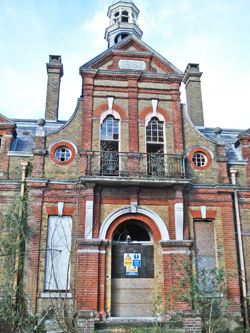
The eastern elevation of the administration block with the main entrance.
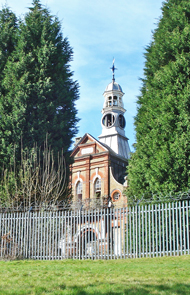
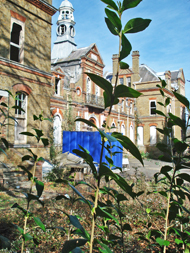
The eastern elevation of the administraion block.

A building at the northeast corner of the site.
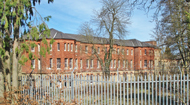

A ward block on the southern side (left). The water tower is visible in the distance (right).
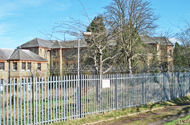

More ward blocks on the southern side (above and below).

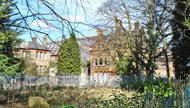
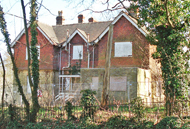

A boarded-up house at the southwest corner of the site.

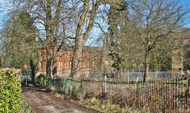
Female ward blocks on the southwest side.

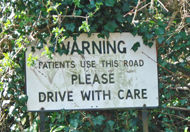
The main driveway with signage (left). An old sign in the driveway (right).
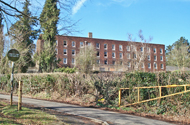
A block to the north of the site - perhaps the former Nurses' Home.
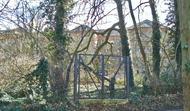
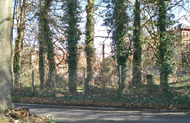
The back of the site, as seen from Portnalls Road.
Update: June 2012
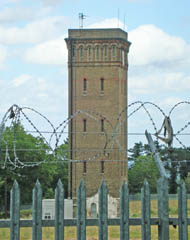
The water tower stands alone, awaiting revelopment.
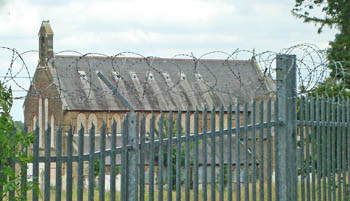
The boarded-up chapel.
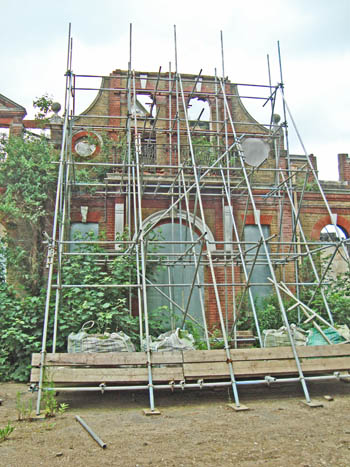
Following the fire, all that remains of the administration building is the front facade.
(Author unstated) 1948 Rescue of a mental patient. British Journal of Nursing (July), 85.
http://en.wikipedia.org
http://hansard.millbanksystems.com
www.20thcenturylondon.org.uk
www.abandoned-britain.com
www.abandonedpast.co.uk
www.canehill.com
www.canehill.org
www.cwra.org.uk
www.derelictplaces.co.uk
www.englishpartnerships.co.uk
www.flickr.com
www.forlornbritain.co.uk
www.geograph.org.uk (1)
www.geograph.org.uk (2)
www.homesandcommunities.co.uk
www.simoncornwell.com
www.slam.nhs.uk
www.southwark.anglican.org
www.thetimechamber.co.uk
www.thisiscroydontoday.co.uk (1)
www.thisiscroydontoday.co.uk (2)
www.yourlocalguardian.co.uk
Return to home page